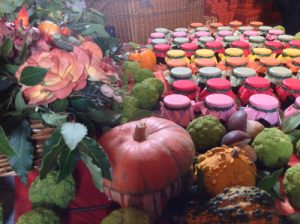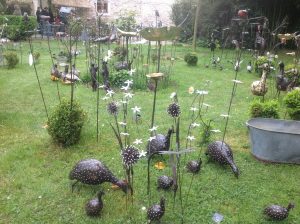The event translated as “Fruit, water and castles” takes place on October 20-21, 2018 from 9.00 to 19.00 at Strassoldo Castle.
Last year, when I visited this exhibition market for the first time, I was fascinated by the beauty of the place and the organization of this event. This cultural event has been taking place every autumn since 1998, and draws in tourists from all over including nearby Austria, Slovenia, and Croatia. The event repeats itself in the springtime appropriately bearing the name of “Flowers, water, and castles”.
The castle, or rather the two fortified castles – Strassoldo di Sopra and Strassoldo di Sotto – were built about 1,000 years ago in a medieval village, surrounded by a park of centenarian trees and bathed by a stream of resurgent waters. Hence their name of Castelli d’acqua or water castles.

For the occasion, the main buildings of the two manors and a series of other buildings are opened such as: the Folador (Friulian dialect for the worker responsible for the fulling of wool), the Pileria del Riso, the Cancelleria and the Vicinia.
The atmosphere is sophisticated in this ancient village; inside the ancient medieval halls, a display of high craftsmanship unfolds as the result of the skillful work of antique dealers, artisans, decorators and exceptional artists.
Every room, every marble staircase, every door and balcony, are adorned with seasonal autumn fruits, and in the spring, with floral bouquets that embellish the creations on display.
LE FURLANE

Perusing through the various rooms, you will find friendly artisans who are eager to tell you the ancient origin of their artifacts.
I was particularly struck by the story of a type of handcrafted slippers made in this region. The slippers in question – if you can even define these wonderful creations – are called furlane. They are a perfect example of recycling, a term very popular in our time.
The furlane were born at the end of the Second World War by the region’s farmers who, unable to afford expensive leather shoes, used everyday materials to create a pair of shoes to put on their feet. Cardboard and jute from seed and grain bags were used to make the soles; old bicycle tires to cover the soles and make them waterproof and resistant; and rags or fabrics from old clothes for the upper portion. The result was practical, soft, and comfortable.

The clever peasants took their crafty furlane all the way to Venice where the gondoliers found them ideal for their craft. They were non-slip and did not scratch the gondolas’ paint.
Like many garments, born for “poor” use, furlane have also undergone a precious evolution thanks to the uppers which are now in velvet, silk, brocade and shantung.
In addition to fabric artifacts, you can admire objects in paper, wood, wax, and ceramics. The autumn exhibition also dedicates a section to Christmas and everything that comes with it. Not to mention the homemade food!

Do not miss the garden where in addition to the wrought iron, you will find a large variety of plants available for purchase.
While you’re in Strassoldo, you can also visit nearby: Aquileia (ancient Roman city), Grado, Palmanova (medieval fortress city) and Villa Manin (home of the last Doge of Venice).
Copyright photo gallery and article: Carla La Rocca

